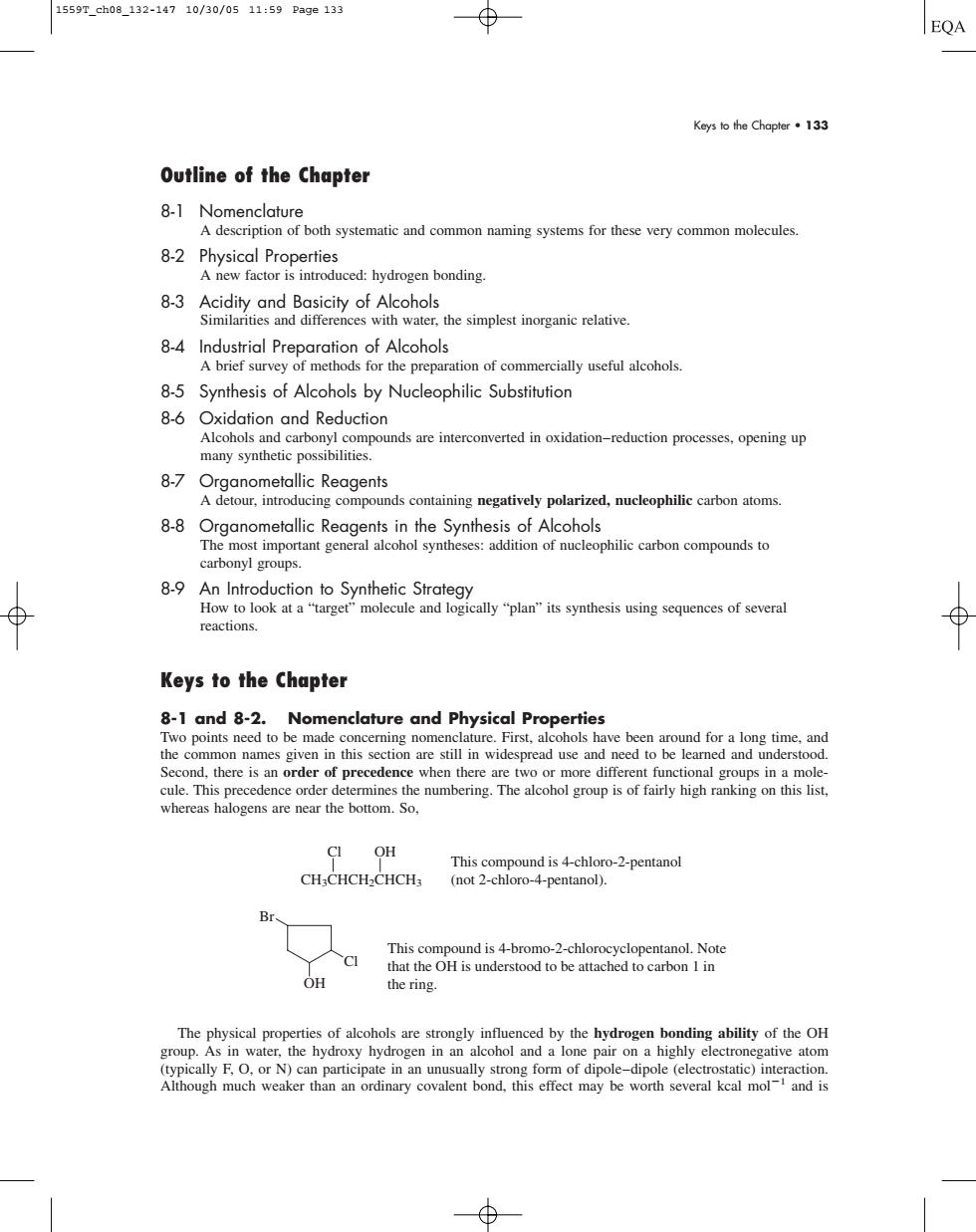正在加载图片...

1559r.ah08.132-14710/30/0511:59Page133 Keyso the Chapter·133 Outline of the Chapter uced:hydrogen bonding 8的eannacckchotetputnweasne 8-4 Industrial Preparation of Alcohols A brief survey of methods for the preparation of commercially useful alcohols. 8-5 Synthesis of Alcohols by Nucleophilic Substitution 8-6 Oxidation and Reduction Alcohols and carbonyl compounds are interconverted in oxidation-reduction processes,opening up many synthctic possibilities. 8782gCaemeacRaogpaomigeaht女pritadamrtntikcaam addition of nucleophilic carbon compounds to carbonyl groups」 8-9 ule and ically"plan"its synthesis using sequences of several reactions. Keys to the Chapter 8-1and8-2. Nomenclature and Physical Properties Second,there is an order of precedence when there are two or more different functio onal groups in a mole cule.Thi CI OH CH CHCH-CHCH: OH the ring. The physical properties of alcohols are strongly influenced by the hydrogen bonding ability of the OH group.Asn the hydroxy hydrogen in an hol and a lone panr on aKeys to the Chapter • 133 Outline of the Chapter 8-1 Nomenclature A description of both systematic and common naming systems for these very common molecules. 8-2 Physical Properties A new factor is introduced: hydrogen bonding. 8-3 Acidity and Basicity of Alcohols Similarities and differences with water, the simplest inorganic relative. 8-4 Industrial Preparation of Alcohols A brief survey of methods for the preparation of commercially useful alcohols. 8-5 Synthesis of Alcohols by Nucleophilic Substitution 8-6 Oxidation and Reduction Alcohols and carbonyl compounds are interconverted in oxidation–reduction processes, opening up many synthetic possibilities. 8-7 Organometallic Reagents A detour, introducing compounds containing negatively polarized, nucleophilic carbon atoms. 8-8 Organometallic Reagents in the Synthesis of Alcohols The most important general alcohol syntheses: addition of nucleophilic carbon compounds to carbonyl groups. 8-9 An Introduction to Synthetic Strategy How to look at a “target” molecule and logically “plan” its synthesis using sequences of several reactions. Keys to the Chapter 8-1 and 8-2. Nomenclature and Physical Properties Two points need to be made concerning nomenclature. First, alcohols have been around for a long time, and the common names given in this section are still in widespread use and need to be learned and understood. Second, there is an order of precedence when there are two or more different functional groups in a molecule. This precedence order determines the numbering. The alcohol group is of fairly high ranking on this list, whereas halogens are near the bottom. So, The physical properties of alcohols are strongly influenced by the hydrogen bonding ability of the OH group. As in water, the hydroxy hydrogen in an alcohol and a lone pair on a highly electronegative atom (typically F, O, or N) can participate in an unusually strong form of dipole–dipole (electrostatic) interaction. Although much weaker than an ordinary covalent bond, this effect may be worth several kcal mol1 and is Cl Br OH This compound is 4-bromo-2-chlorocyclopentanol. Note that the OH is understood to be attached to carbon 1 in the ring. Cl OH CH3CHCH2CHCH3 This compound is 4-chloro-2-pentanol (not 2-chloro-4-pentanol). 1559T_ch08_132-147 10/30/05 11:59 Page 133